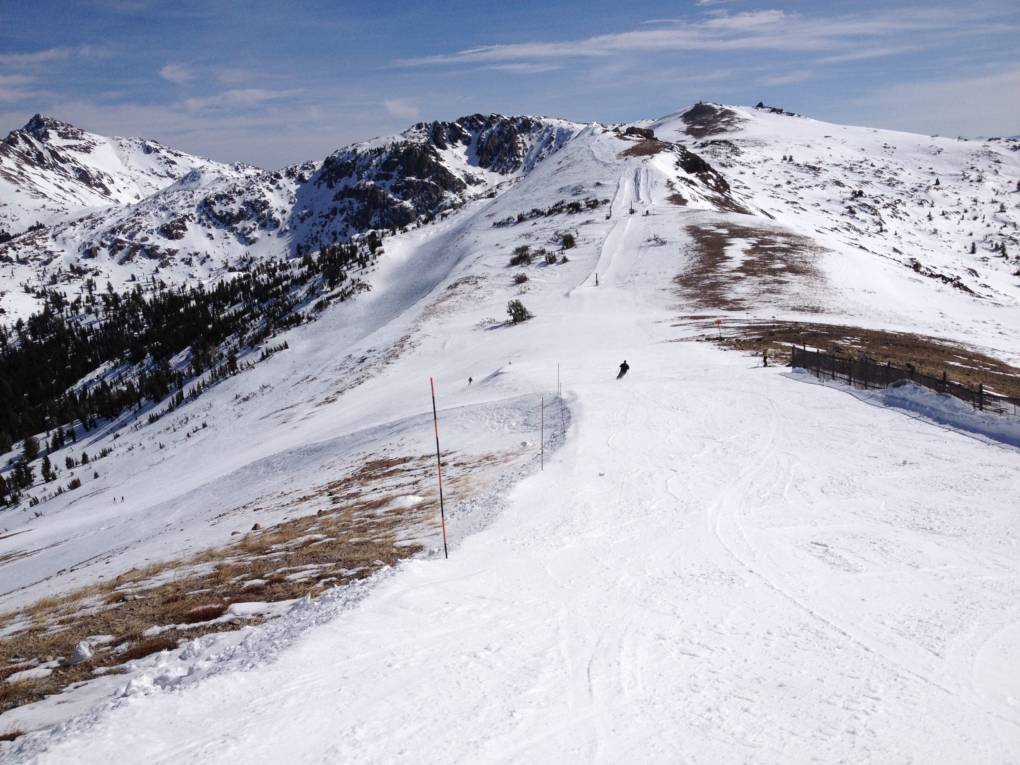While some resorts are struggling, Vail group is expanding and insulating itself

What a difference a season makes at one laid-back California ski area known for deep powder, sweeping bowls and short lift lines.
Kirkwood Mountain Resort, located 35 miles southwest of the glittering mega resorts of Lake Tahoe, is well off its average of 500 inches of snow per year (and a far cry from last year’s record-setting 748 inches). This weekend’s North Face Masters big mountain snowboard competition has been postponed because of lack of snow on the area’s high cirques. And last Wednesday, the resort was bought for $18 million by Colorado-based Vail Resorts.
Kirkwood’s purchase by Vail, a company whose aggressive expansion and intensive development at its other ski areas (including Tahoe resorts Heavenly and Northstar) may portend multi-million dollar ski chalets, luxury boutiques and high-speed gondolas — all things the remote Kirkwood has eschewed in its 40 years of operation.
But according to some industry watchers, Vail’s business model may offer economic insulation from a changing climate, as California’s mountain snowpack is projected to decline by as much as 25% by mid-century.
[module align=”left” width=”half” type=”pull-quote”]Vail’s adaptation to the changing weather involves offering skiers more choices — not in terms of terrain, but places to spend their money after the lifts close.[/module]
The threat of dwindling snowfall and warming temperatures is by no means limited to the ski areas of the High Sierra. The issue has become a key focus of the United Nations World Tourism Organization, which produced a 2008 report titled “Climate Change and Tourism” (PDF). One study cited in the U.N. report examined the New England ski industry during the 2001-2002 season, when average temperatures during the ski season were a staggering eight degrees Celsius higher than those between 1961 and 1990. Between 2001 and 2002, the ski season was shortened by 11% and increased snowmaking led to a 35% increase in energy use. The study concluded that warmer-than-average seasons reduced operating profits by 19% when compared to “climatically average seasons.”
Vail’s adaptation to the changing weather involves offering skiers more choices — not in terms of terrain, but places to spend their money after the lifts close. (One statistic on the Vail webpage sums up how critical its off-mountain ventures are to its bottom line: “29,035: ‘The height of Mt. Everest and the stacked height of all ski boots sold annually by our retail outlets.’”
Earlier this month, Derek Thompson at theatlantic.com characterized Vail’s (and chief rival, Canadian ski company Whistler/Blackcomb) economic epiphany like this:
What Vail and Whistler have discovered is that lift-tickets. . . will always provide the foundation of ski-nomics. But a resort that offers only skiing is a terribly risky business model — like a snow farmer whose yearly harvest is only as good as the snow crop.
According to Vail’s latest financial report (PDF), 36% of its $807 million in revenues during the 2010-2011 season came from lift ticket sales. The other 64% was divided between lodging, dining, ski school and retail and rental sales.
More telling, however, are the company’s numbers from the 2009-2010 season (PDF). In spite of a poor economy and historically low snowfall totals, Vail reported a revenue increase of nearly four percent. “Vail has a range of auxiliary services that really helps to round out its business,” said Troy Hawks of the National Ski Area Association, a Colorado-based trade group. And here’s the key: Vail is “vertically integrated,” meaning it does not merely offer these services — it owns them.
Those who love resorts like Kirkwood precisely because of their lack of amenities may find cold

comfort in such figures. (Indeed, Vail’s flagship resort, tucked into a picturesque valley some 90 minutes west of Denver, has often been described as a bad caricature of a Tyrolean village.)
Kelly Ladyga, a spokesperson for Vail Resorts, said plans for the Kirkwood village are still being discussed, but she noted that Vail has done more than build up the base amenities at its various resorts, pointing to efficiency improvements of lifts and snowmaking equipment. Hawks echoed Ladyga’s comments. “When you have a large corporation like Vail, you have access to lots of capital and know-how that you might not have with, say, a smaller, independent company.”
Last week, as I rode the Sunrise Lift in 50-degree temperatures to Kirkwood’s vast bowls under 9,800-foot Thimble Peak, I sat next to Jim, a Heavenly season pass holder. “I don’t think this will ever become another Vail,” he said. “But a few more high-speed lifts to access all this great terrain wouldn’t hurt.”
One thought on “Ski-nomics: The Business of Ski Resorts in a Future with Less Snow”
Comments are closed.


With Vail and so many other business enterprises making the intelligent step of “insulating” themselves against climate change, one wonders why politicians are still so hesitant to act. Dante described a special place for those who “do nothing in a time of moral crisis” Clearly, climate change can be described as a scientific issue that is basically resolved. Our reaction to it is a moral issue and resolution seems a long time coming.